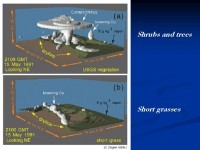The theory is highlighted in a recent study report compiled by two researchers from Britain's Portsmouth University, Nicholas Pepin and Martin Schaefer, who surveyed the mountain's glaciers for 11 days.

|
| ©Unknown |
The researchers, who revealed their findings at a news conference in Dar es Salaam yesterday, said the mountain's glacier surface had shrunk from 20 km in 1880 to a mere two kilometres in 2000.
They said the development was caused more by local than regional factors, with Pepin suggesting that deforestation mainly due to extensive farming as the major cause.
''Deforestation of the mountain's foothills is the most likely culprit because without forests there is too much evaporation of humidity into outer space.
The result is that moisture-laden winds blowing across those forests have become drier and drier,'' he explained.
''Loss of humidity automatically leads to a reduction in cloud cover. Clouds play a crucial role in protecting ice from sunrays, with fewer sunrays meaning faster freezing of water,'' he added, citing reduced precipitation as another reason for the receding ice cover on the mountain's summit.
Last year, another study on the dwindling ice cover on the mountain's cap suggested that global warming had nothing to do with the alarming loss of its beautiful snows.
The scientists who conducted the study, US-based Philip Mote and Georg Kaser, assertively linked the problem to a process known as sublimation.
Recent scientific literature on climate and glacier formation defines sublimation as a process that occurs at below-freezing temperatures and converts ice directly to water vapour with the liquid phase skipped.
Mote likened the process to moisture-sapping conditions that cause food to suffer freezer burn.
Revealing the findings they first published last year in the American Scientist magazine, the experts cautioned that using Mount Kilimanjaro as a ''poster child'' for climate change was awfully inaccurate.
They said in the tropics, particularly on Mount Kilimanjaro in Tanzania, processes are at work that are worlds different from those that have diminished glacial ice in temperate regions closer to the poles.
The two experts wanted the world to ditch old assertions and believe that the ice loss on Mount Kilimanjaro was mainly due to sublimation, which calls for over eight times as much energy as does melting.
Like their British counterparts yesterday, the US-based scientists linked the icecap loss to a fall in precipitation caused by Indian Ocean ''variability''.
In remarks at yesterday's news conference, Journalists Environmental Association of Tanzania chairman Deo Mfugale also linked the loss of glaciers on Mount Kilimanjaro to human activities rather than global warming.
He called for an end to the random felling trees and burning forests, mainly done for charcoal and timber, saying these and related practices led to the destruction of some 15 per cent of forests in Tanzania between 1976 and last year.
Kibo volcano is widely acknowledged as located at the highest point on Mount Kilimanjaro at about 5,895 metres (19,340 feet) above sea level.
According to a rough 1889 survey Kibo's icecap occupied about 12.5 square miles but this had dwindled to about 7.5 square miles by 1912, to about 4.3 square miles by 1953, and just over 1.5 square miles by 2003.



Reader Comments
to our Newsletter